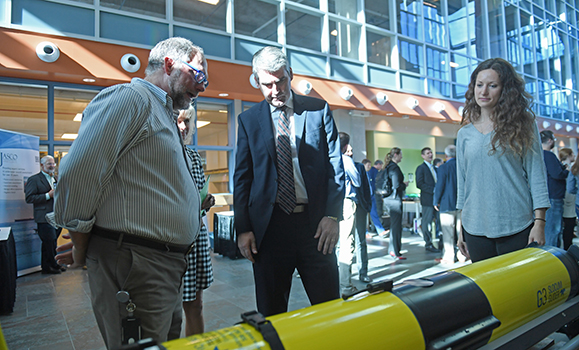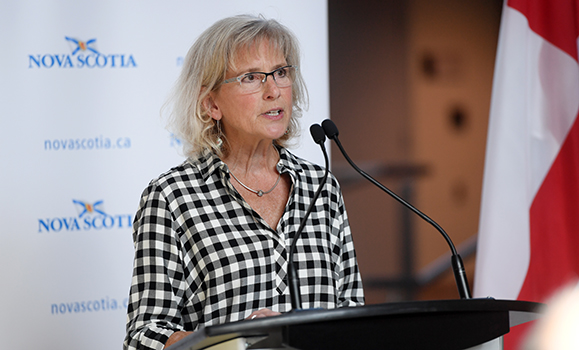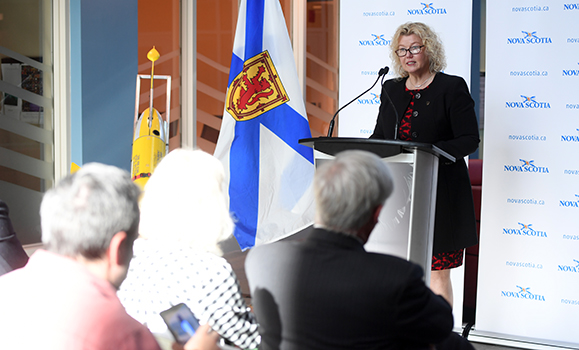Nova Scotia Premier Stephen McNeil announced Tuesday (October 24) that nine research projects at four post-secondary institutions will receive more than $6.5 million in funding aimed at strengthening ocean science and marine technology development, tidal energy and combating coastal erosion.
One of the projects based at H¬ĢĽ≠ is DAMOS (Development of Autonomous Marine Observation Systems). DAMOS combines autonomous Slocum and Wave Gliders and fixed-tracking stations, providing the ability to make oceanographic and animal tracking measurements with unprecedented resolution in key areas of the Northwest Atlantic.
Among DAMOS’s many benefits, it will help protect the North Atlantic right whales, one of the most endangered cetaceans.  

‚ÄúThrough the use of autonomous vehicles and sensors, we‚Äôll be able to strengthen our ability to monitor and locate right whales, identifying their real-time locations,‚ÄĚ said Sara Iverson, professor, Department of Biology and Scientific Director of the Ocean Tracking Network which co-leads DAMOS. ‚ÄúThrough technology, we‚Äôll also be able to relay that information to the shipping and fishing fleets who share the sea with the right whales, allowing them to chart a course that mitigates conflict with this endangered species.‚ÄĚ
Found mostly along the Atlantic Coast, right whales have been threatened by entanglement in fishing gear and collisions with ships. It’s estimated that less than 500 right whales are in existence. This past summer, an unprecedented number of North Atlantic right whale mortalities were reported in the Gulf of St. Lawrence.

‚ÄúThis project positions Canadian scientists to make major breakthroughs in our understanding of the ocean and its resources,‚ÄĚ said Dr. Iverson (above).
‚ÄúH¬ĢĽ≠ is home to the first and only comprehensive and operational glider team in Canada which is leading the way in ocean observing technologies and training. Additionally, the fixed receiver-tracking systems are made-in-Nova-Scotia-technology, further positioning our province ‚ÄĒ and Dal ‚ÄĒ as a world leader in marine research and industry.‚ÄĚ
Research funding generates broad benefits
Five other Dal-led projects received funding from the province:
- Alex Hay - Environmental Monitoring, Modelling and Forecasting Infrastructure for
Instream Tidal Energy - Stefanie Colombo - Finfish and shellfish tank systems to improve nutrition in aquaculture
- Mladen Nedimovic - National Facility for Seismic Imaging
- John Gosse ‚Äď microSTARR, Ultra Sensitive Tracer Analysis for Radioisotope Research
- Bruce Martin - Effectiveness of acoustic monitoring systems and turbine audibility assessment.

‚ÄúI am so very proud of our world-class researchers whose incredibly innovative work is generating an unprecedented understanding of our ocean,‚ÄĚ says Alice Aiken (above), vice-president research for H¬ĢĽ≠. ‚ÄúThe financial support announced today allows us to increase our capacity for discovery and innovation and offer rich research environments¬†that foster¬†leading-edge¬†work.‚ÄĚ
Acadia University, St. Francis Xavier University and Nova Scotia Community College also received funding.
‚ÄúNova Scotia has a competitive advantage in the ocean sector and we are supporting research that will have the greatest impact on the province‚Äôs economy,‚ÄĚ said Premier McNeil.
The funding is expected to create more than 170 jobs and support training for approximately 200 graduate students, interns, lab technicians, project managers and faculty.
The OFI connection
Dr. Iverson‚Äôs research is also supported by the (OFI), an international hub for ocean science led by H¬ĢĽ≠ University, Memorial University of Newfoundland and the University of Prince Edward Island. She is involved in three OFI projects:

